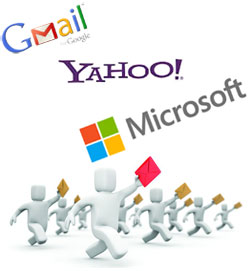
A few short months ago, two warning shots were fired by major email service providers. The first was Gmail’s announcement that incoming emails would automatically be sorted into tabs. The second was Yahoo’s decision to reuse dormant email addresses. There has been a lot of debate about the effect of Gmail’s new interface on email marketing. Discussion about the Yahoo changes pale in comparison. Both events are signs of things to come. The rules for email engagement are changing.
It’s only a matter of time before all major email service providers join Gmail and Yahoo. Microsoft has already announced that dormant email addresses would be reclaimed. The plan is to eliminate user access after 270 days of inactivity. The email addresses will then be released after another 360 days have passed. Changes to interfaces will take more time because it requires a major overhaul of the software. Make no mistake, the changes are coming and will be here sooner than you think.
Email marketing is evolving at a rapid pace. The days where cash flow could be generated by simply collecting addresses and emailing promotional offers are disappearing. The new reality requires segmentation, targeted marketing, and customer engagement. The methods for planning a successful email marketing campaign have become remarkably similar to creating a direct mail program.
This change is bad news for companies and individuals that blast their way to revenue. It’s very good news for marketers truly interested in serving customers. When there is a good relationship between sender and the recipient, emails will be read and responses will happen. A study by Return Path looked at the Gmail effect on marketing emails for recipients with high, medium, and low engagement levels. The following chart shows the results:
It shouldn’t surprise anyone that the read rate for highly engaged recipients is still strong. In fact, it is slightly higher at 2.11%. People who love your company, products, and service will find and respond to your messages. I suspect the slight increase is because people have either moved the emails to the primary box or are in a shopping frame of mind when they hit the promotional tab.
Recipients with a medium level of engagement had a decrease of 7.01% in the read rate. This is significant but not nearly as much as the results for recipients with a low engagement level. Their read rate after the rollout dropped 80.82%. This shows us that engagement is key to email marketing.
There is nothing new about better responses from people who are more engaged. Some marketers already have everything in place to benefit from the changes. Others, operating with an “if it’s not broke, don’t fix it” mentality, have some work to do. The activities that increase customer loyalty and retention also improve deliverability and response. This means that you don’t have to completely revise your marketing strategy. Basically, there are two things to do to prepare for the changes – increase engagement levels and keep your database clean.
You will want to do more because email can be used to retain customers, provide better service, educate people about your business, and reduce operational costs. The changes in the rules of engagement are a catalyst to improvements strategically designed to increase loyalty.
Here are some tips to get you started:
Clean your database – The first step is to remove all known bad addresses. Consider sending a message to subscribers that haven’t responded in a while that requests a response to let you know they still want to receive your emails (the time period for “while” needs to be defined by you.)
Create a segmented report by service provider – The effect of the changes on your campaign is all that matters. What happens globally may be very different from your experience. A segmented report allows you to see trends that won’t show in other analysis.
Continue the strategy that is working now – Changing your email marketing strategy is a process not an event. Continuing the strategy currently working keeps revenue flowing while you plan and test new campaigns.
Focus on engagement – Promotional emails will always be a primary part of every successful strategy. Add messages that improve retention, educate recipients, and improve service to your marketing mix.
Create a direct marketing campaign – The same tactics that work with catalogs and direct mail work with email marketing. Segment your file and target people with messages designed to speak directly to them.
Find more tips improving your email marketing strategy in 31 Ways to Supercharge Your Email Marketing.

















Great article i world say and i think i learn lots of thing about the article